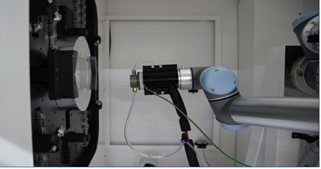News & Media
Development of SiC material for space optics and ultra-precision polishing technology
- NameKFE
- Date2020-06-05
- Hit508
|
|
|
|
(from left) Jang Soo Ouk, Lee Kang Il, and Seok Dong Chan, researchers of the Research Team |
Hybrid plasma generator that generates plasma Of a balanced filament and glow structure |
Plasma is the fourth state of matter, a gas composed of electrons and ions dissociated from atoms or molecules composing the gas. Plasma is found not only in natural phenomenon such as lightning, aurora and stars in the sky, but it is also a very useful tool in various industries such as electronic devices manufacturing, metal or ceramic/glass melting, flue gas purification, welding for construction, etc. Plasma, which has been leading the cutting-edge industry with various surface treatment technologies, has begun to be used in the processing of free-form ultra-precision optical systems, one of the main components of satellites.
The optical system, called the eye of a satellite, is similar in function and structure to a normal camera lens. In order to clearly shoot objects of 10 cm size on the ground from 10,000 km above the earth, neither fine scratches during manufacturing nor small deformations in the space environment can be tolerated. In early years, glass was mainly used; however, it could not endure the large difference in temperature in space, ranging between 120°C and -180°C.
SiC has already been widely applied to metal machining tools, aircraft tires, and brakes, and is also suitable as a satellite material, which require weight reduction, given that SiC’s weight is only a third that of glass. The problem, however, is that there is no equipment to grind such inert and rigid material, and conventional machining methods require many complex steps. Plasma, on the contrary, can process the surface of SiC without any physical contact.
Atmospheric pressure plasma surface processing technology has already been successfully applied in attempts to impart properties such as coating power, plating power, deposition power, and printing power to the surfaces of various materials such as LCD, metal, rubber, and plastic. The technology developed by our research team is an atmospheric pressure hybrid plasma generator that controls the irregular shape and spatial position of the atmospheric plasma; it is almost a kind of engraving knife. Atmospheric pressure plasma is divided into a ‘glow’ structure of uniform and relatively large volume and a ‘filament’ structure composed of numerous intense and thin strand volumes. The filament discharge is also classified into arc, spark, and streamer corona, according to its strength and shape.
Silicon, the main material of semiconductors, can be etched by glow plasma, but the chemically inert and very hard SiC material requires strong filament plasma. However, if we use lightning, like that branching in all directions with an unstable shape, to process the surface of the optical system, then only irregular scars will remain, as if the surface had been swept with a wispy broom. The problem is that it is difficult to control the filament structure at atmospheric pressure. Filament plasma constantly changes its shape and position with slight changes of the environment and the surface condition of the contacting material. After countless trials and errors, the research team developed a very stable and strong branchless filament plasma generation device.
This is the result of countless experiments in which the unique conditions of the experiments were recordedand memorized and then reproduced again to the extent that the hybrid condition in which the glow and thefilament stably coexist was completed. The team derived an optimal process using compressed and sintered SiC,and verified its performance by using SiC in the wafer state. Already in 2017, the research team had developed aneedle-like pointed atmospheric plasma with a polishing level at 5nm; in 2018, it improved the polishing levelto 0.5nm or less. When using a vacuum plasma, ultra-fine polishing level of 0.2nm is also possible, which istwice or more the roughness of 1nm, which was the initial target of the team. Atmospheric pressure plasma SiCprecision polishing df satellites.
evice can be used as a correction polisher for an SiC mirror, and in the case of a vacuumdevice, it is a source technology called SiC atomic layer etching, which is the first example of the application ofthe concept of exfoliating a material atomic layer by layer, rather than by simply peeling SiC, which combinestwo elements of silicon and carbon.
The advantage of the atmospheric pressure plasma SiC process is that two time-consuming steps of the totalSiC figuring steps can be unified into only one time-saving step. To date, a polishing step is required to finelypolish the rough surface; this involves using an ion beam after quickly peeling SiC by primary machining.However, using plasma, a single-step process is sufficient because the surface is not rough. In 2019, the projectentered the industrialization development stage, which is the second stage, and began to develop a plasmaprocessing machine focused on user convenience, aiming at processing objects having diameters of 600mmthat can be used in actual industrial sites.
SiC material with ultra-high purity is expected to be used in power devices for electric vehicles, hybrid cars,energy conversion devices for solar devices, and power devices for various electronic products for which energysaving is required. Thus, the processing technology development this time is expected to play a major role inthe relevant industries.

보안문자를 입력 후 확인 버튼을 누르세요.


